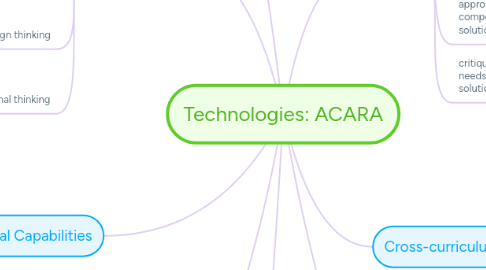
1. Key Ideas
1.1. Creating preferred futures
1.1.1. Students will be given the opportunity to see how solutions that are created now will be used in the future. Students use critical and creative thinking to weigh up possible short and long term impacts. As students progress they will begin to identify possible and probable futures, and their preference for the future.
1.2. Project management
1.2.1. Students will develop skills to manage projects successfully from planning through to execution.
1.3. Systems thinking
1.3.1. Is a holistic approach to the identification and solving of problems where the focal points are treated as components of a system. The success of designed solutions includes the generation of ideas and decisions made throughout design processes.
1.4. Design thinking
1.4.1. Involves the use of strategies for understanding design needs and opportunities, visualising and generating creative and innovative ideas, planning, and analysing and evaluating. Design thinking underpins learning in D&T.
1.5. Computational thinking
1.5.1. Is a problem solving method that is applied to create solutions that can be implemented using digital technologies. It involves integrating strategies.
2. Content Structure
2.1. Subjects
2.1.1. Design and Technologies
2.1.2. Digital Technologies
2.2. Strands
2.2.1. Knowledge and Understandings
2.2.1.1. Design and Technologies
2.2.1.1.1. Technologies and society
2.2.1.1.2. Technologies contexts
2.2.1.2. Digital Technologies
2.2.1.2.1. Digital systems
2.2.1.2.2. Representation of data
2.2.2. Processes and production skils
2.2.2.1. Design and technologies
2.2.2.1.1. Creating design solutions by investigating, generating, producing, evaluating, collaborating and managing
2.2.2.2. Digital Technologies
2.2.2.2.1. Collecting, managing and analysing data
2.2.2.2.2. Creating digital solutions by defining, designing, implementing, evaluating, collaborating and managing.
3. General Capabilities
3.1. In the Australian Curriculum, the general capabilities encompass the knowledge, skills, behaviours and dispositions that, together with curriculum content in each learning area and the cross-curriculum priorities, will assist students to live and work successfully in the twenty-first century.
3.1.1. •Literacy •Numeracy •Information and communication technology (ICT) capability •Critical and creative thinking •Personal and social capability •Ethical understanding •Intercultural understanding.
4. Student Diversity
4.1. All students are entitled to rigorous, relevant and engaging learning programs drawn from the Australian Curriculum: Technologies. Teachers take account of the range of their students’ current levels of learning, strengths, goals and interests and make adjustments where necessary
4.1.1. Students with disabilities
4.1.1.1. Adjustments to the delivery of some practical aspects of lessons will be necessary to ensure some students with physical disability can access, participate, and achieve on the same basis as their peers
4.1.2. English as an additional language or dialect
4.1.2.1. These students may require additional time and support, along with teaching that explicitly addresses their language needs. Students who have had no formal schooling will need additional time and support in order to acquire skills for effective learning in formal settings.
4.1.3. Gifted and Talented students
4.1.3.1. Teachers can enrich student learning by providing students with opportunities to work with learning area content in more depth or breadth; emphasising specific aspects of the general capabilities learning continua
5. Achievement Standards
5.1. The sequence of achievement standards in each Technologies subject describes progress in the subject, demonstrating a broad sequence of expected learning by the end of the band. This sequence provides teachers with a framework for development in each Technologies subject. The achievement standards for Technologies reflect the distinctive practices of each subject along with aspects of learning that are common to the Technologies subjects. Subject-specific terms and organisation reflect the essential characteristics of learning in each subject. The achievement standards also reflect differences in the nature and scope of the learning in each subject, as well as the relationship between the interrelated strands: Knowledge and understanding and Processes and production skills. Achievement standards will be accompanied by portfolios of annotated student work samples that illustrate the expected learning and help teachers to make judgments about whether students have achieved the standard.
6. Aims
6.1. Investigate, design, plan, manage, create and evaluate solutions
6.2. are create, innovative and enterprising when using traditional, contemporary and emerging technologies, and understand how technologies have developed over time.
6.3. make informed and ethical decisions about the role, impact and use of technologies in the economy, environment and society for a sustainable future
6.4. engage confidently with and responsibly select and manipulate appropriate technologies − materials, data, systems, components, tools and equipment − when designing and creating solutions
6.5. critique, analyse and evaluate problems, needs or opportunities to identify and create solutions
7. Cross-curriculum priorities
7.1. Aboriginal and Torres Strait Islander histories and culture
7.1.1. Students identify and explore rich and diverse knowledge and understandings of technology employed by Aboriginal and Torres Strait Islander Peoples in past, present and future.
7.2. Asia and Australia's engagement with Asia
7.2.1. Students explore traditional, contemporary and emerging technological achievements in the countries of the Asia region.
7.3. Sustainability
7.3.1. Prepares students to take action to create more sustainable patterns of living. Students focus on technologies and systems with regard to costs and benefits.
8. Band Levels
8.1. •Foundation –Year 2 •Years 3 and 4 •Years 5 and 6 •Years 7 and 8 •Years 9 and 10.
8.1.1. Content descriptions
8.1.1.1. Content descriptions in each subject across the bands focus on similar organising elements that present a developmental sequence of concepts, skills and processes
8.1.2. Band descirptions
8.1.2.1. provide information about the learning contexts that apply to the content descriptions and achievement standards in each Technologies subject in each band. They also emphasise the interrelated nature of the two strands and the expectation that planning will involve integration of content from across the strands
8.1.3. Content elaborations
8.1.3.1. They are intended to help teachers in developing a shared understanding of the content descriptions
